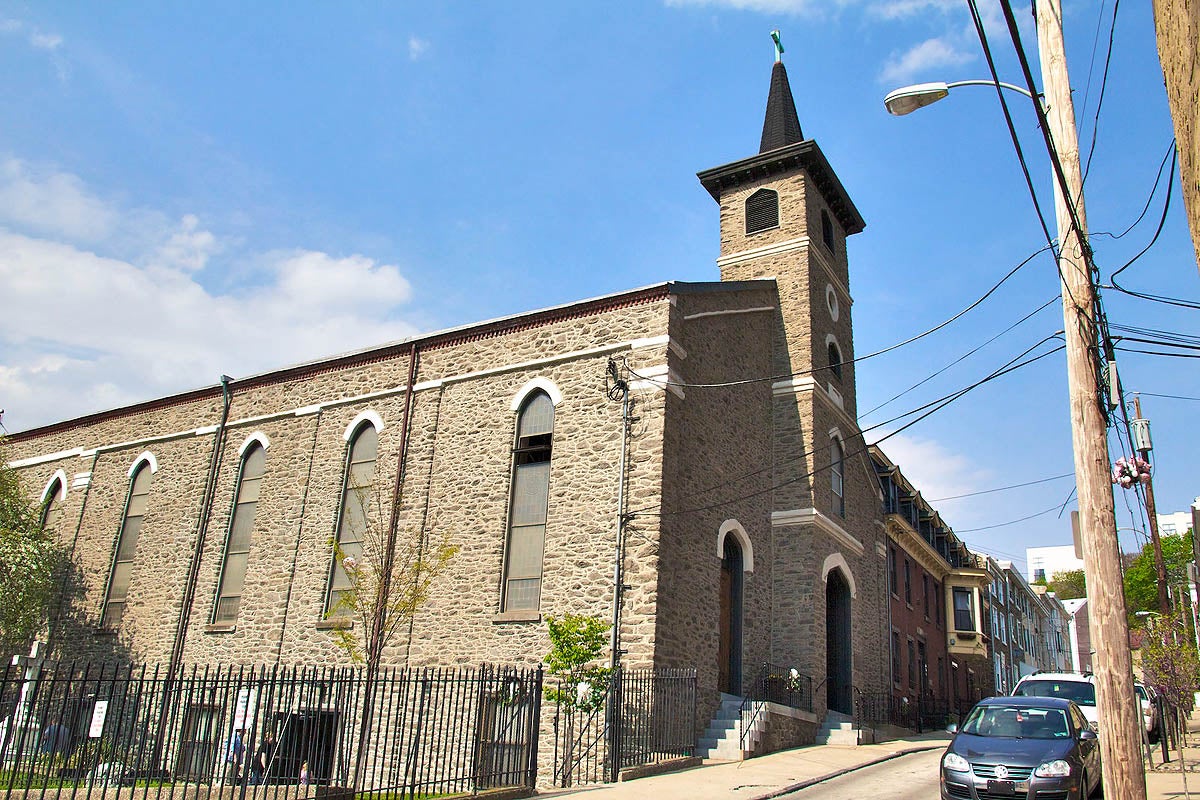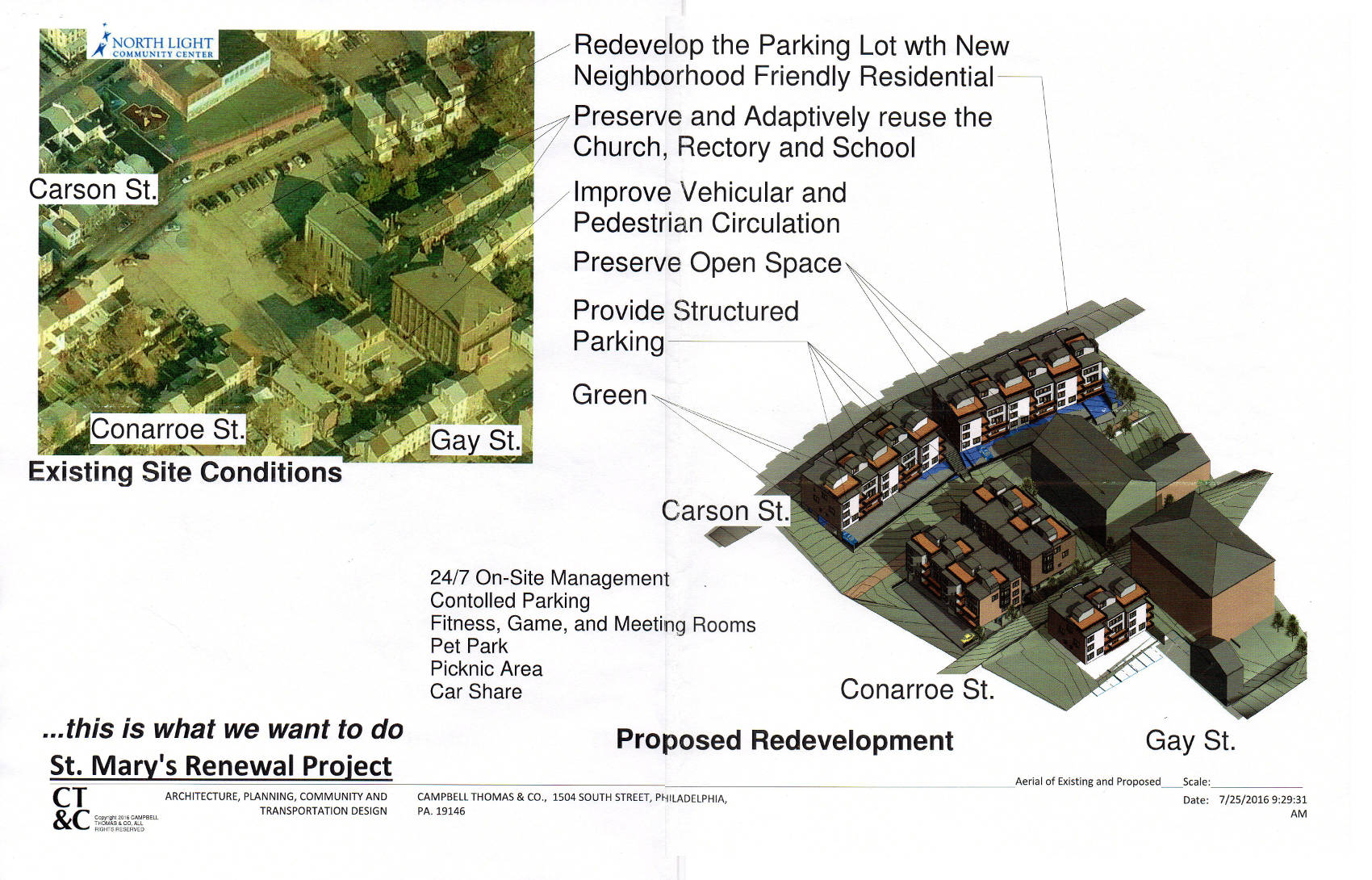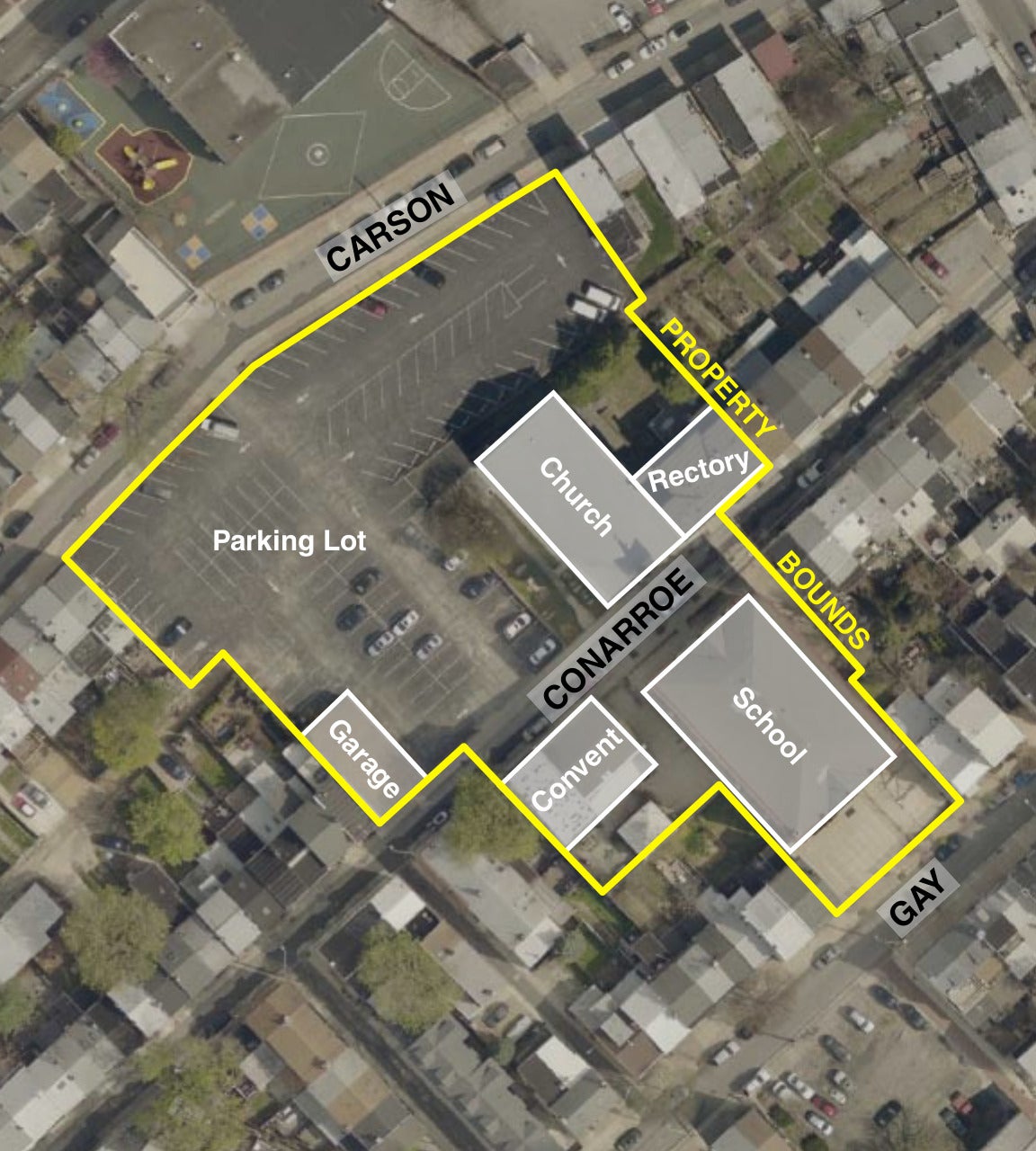Redevelopment approach to St. Mary’s site frustrates Manayunk neighbors

In a community as dense as Manayunk, any development proposal that will bring more housing units and fewer parking spaces faces a tough fight from longtime residents who feel the neighborhood is already bursting at the seams.
At a meeting of the Manayunk Neighborhood Council (MNC) on December 14, the fight was over those issues, but also how to best control them.
The current battleground is the site of St. Mary of the Assumption, 176 Conarroe St., a one-acre property that includes a closed Catholic church building, rectory, school, and parking lot currently used by about 50 neighbors. Like much of Manayunk, it’s tucked in an enclave of narrow one-way streets lined with small, tightly packed rowhomes. A developer has proposed 100 apartments and 130 parking spaces at the site, a proposal that would require a zoning change from single-family residential to allow apartments.
Most of the residents’ anger at the community meeting was directed at their local representative, 4th District Councilman Curtis Jones, who has asked the Philadelphia City Planning Commission to create plan of development for the entire St. Mary’s campus that would likely include a zoning change.
A plan of development would lock in details like the number and size of housing units, where buildings are located, and the amount of parking spaces. Jones’ office and the Planning Commission see the creation of such a plan of development as a proven way to reach agreement about a larger-scale project that also binds a developer to the agreed-upon plan.
But to the neighbors, Jones’ approach completely bypassed their concerns. “The councilman took an unprecedented position to support the developer,” MNC president Kevin Smith said.
Historic parish
Construction of St. Mary of the Assumption was completed in 1849, one of the first churches erected for Philadelphia’s German-speaking Catholic communities. The church was built by German stonemasons in the architectural style of its European forbears, and it served the working-class residents of the thriving mill town. The school building was added in 1867, and the church, school and rectory were the centerpiece of the religious and cultural life of the community for more than a century.
The Archdiocese of Philadelphia began closing and merging the churches in Manayunk in 2012 due to shifts in the Catholic populations, the density of parishes, declining attendance, and economic challenges. St. Mary’s was merged into St. John the Baptist nearby. The final Mass was celebrated at St. Mary in July 2012, but it continued to serve as a worship site and to host weddings and funerals. The doors were finally closed in November 2015.
The historic and cultural significance of the church, rectory and school were the basis of a nomination in April 2016 and subsequent designation on the Philadelphia Register of Historic Places.
Development plans
Last March, the Manayunk Neighborhood Council learned that developer Jack Bienenfeld had entered an agreement of sale with the Archdiocese of Philadelphia for the St. Mary’s property.
“We haven’t been given any plans, and they haven’t filed for any permits,” Smith, the MNC president, told the meeting of 70 residents last week. “But we know they have plans for a multi-family development, and that’s not a place to start negotiations.”
MNC trustee John Hunter said MNC members met with the developer’s architect, Jim Campbell, three months ago, and were told that Bienenfeld would preserve the church, rectory and school but demolish an adjacent convent building.
The empty lot at St. Mary’s has been used by about 50 residents for parking since the closing of the church. Smith said none of the plans they have seen allow for any community parking at the site.
Smith said in October neighbors learned Councilman Jones asked the Planning Commission to create plan of development, with requisite zoning changes, for the St. Mary’s property. “We think that’s a non-starter,” he said.
“Jones did this despite our objections and without meeting with us,” Smith said. “If he ignores the community and City Council passes it, we will have no recourse. This will change the neighborhood’s zoning,” Smith said.
The plan of development and associated zoning changes would apply to the one-acre St. Mary’s site alone.
Irene Madrak, executive director of the North Light Community Center, which hosted the community meeting, said the current plan for developing the St. Mary’s site also could have a major impact on the community center. North Light’s tutoring, food distribution, career preparation and other programs would be endangered if visitors did not have access to parking, she said.
“The loss of off-street parking is the biggest threat to the continuation of our organization,” she said.
Start of a process
Representing Councilman Jones at the meeting was his Deputy Chief of Staff, Josh Cohen, who said the request for a plan of development for the site is “a jumping off point,” not a conclusion to the process.
“This is not a zoning overlay or spot zoning. It is the creation of a master plan that is meant to get the community and developers together to come up with comprises,” Cohen said.
The current residential zoning for the St. Mary’s property does not require any parking, and new tenants would probably take all the spaces that were available, he said. “So we are seeking a plan that has other options.”
Jones has the “best interests of his constituents at heart,” Cohen said. “This is the first of many meetings that will take place over the course of several months. We have not introduced any plan,” he explained.
Cohen said that Jones had recently completed a master plan in East Falls to meet the needs of Philadelphia University, area developers, and surrounding residents. The plan involved 80 acres and the process took a year and half to complete.
“The Councilman was able to control the process, and he wouldn’t agree to anything until the neighbors agreed,” Cohen said.
Matt Wysong, the Planning Commission’s Northwest Philadelphia community planner, said the historic designation of the St. Mary’s also determined the need for a master plan for the property.
The church, school and rectory are protected and limit what the developer can do with the buildings. But the current single-family residential zoning technically means that only one family can live in each of those buildings. “That guided the process that we advised the Councilman to take,” Wysong said.
Wysong said the “historic nature of the site will require higher density zoning. But there must be agreement on the master plan before anything is introduced.”
Residents will have many opportunities to air their concerns during the master plan process, Cohen said, including hearings before the City Council rules committee, Civic Design Review committee, Historical Commission, and Planning Commission.
“We’re trying to make this something that is as manageable and neighborhood-friendly as possible,” Cohen said.
Master plans have been developed for specific sites in Mt. Airy, Upper Roxborough and Chestnut Hill in recent years, Wysong said. “It’s the best way to go. Compromise is the name of the game.”
WHYY is your source for fact-based, in-depth journalism and information. As a nonprofit organization, we rely on financial support from readers like you. Please give today.





